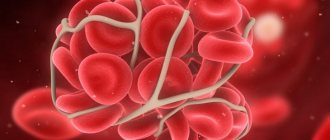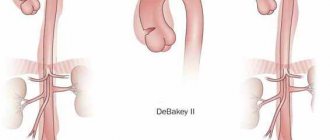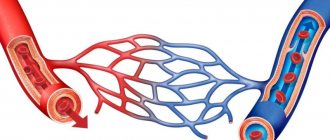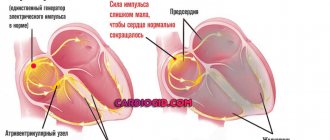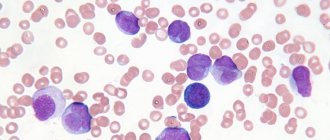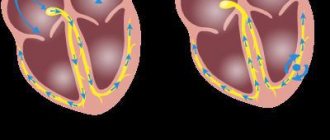Polyneuropathy is a term that refers to various forms of diseases caused by the destruction of nerve fibers. The common element of such pathological conditions is dysfunction of the peripheral nervous system.
Usually the disease affects the upper and lower extremities, which is accompanied by a decrease in the sensitivity and performance of muscle fibers, and a deterioration in blood supply. This condition can lead to paralysis and loss of sensory sensitivity.
Characteristics of the concept
The nervous system is differentiated into autonomic, central and peripheral. Each of the systems has its own departments, nerve plexuses, and endings. Diseases of the brain and spinal cord are the most difficult to treat. Disorders of the peripheral nerves are especially dangerous, since they innervate tissues, organs, and limbs. When several symmetrical nerve fibers are affected simultaneously, polyneuropathy is diagnosed.
The pathological condition has many names: neuropathy, polyradiculoneuropathy, polyneuritis. The latter term denotes the presence of a focus of inflammation. This is unusual for peripheral nerve endings, so it is more correct to use other names for the disease.
Polyneuritis translated from Greek means “damage to many nerves.”
The nerve fiber is represented by the myelin sheath and axon. Neuropathy can affect a specific area in the structure of the nervous tissue. When the axon is destroyed, the disease develops slowly, manifesting itself in atrophy of the legs and arms. This is due to dysfunction of the autonomic system. The destruction of the myelin sheath occurs at a rapid pace. As a result, motor and sensory functions are impaired.
Hypothyroidism (axonal)
Hypothyroidism is a decrease in thyroid function. As a result, sensitivity in the extremities is impaired: the feet are first involved, and they are affected more severely than subsequently the arms. Pain and tingling are also common symptoms. Sometimes polyneuropathy can slightly bother a person for a long time, but doctors make a diagnosis only after several years. If a person takes hormone replacement therapy, polyneuropathy usually goes away along with hypothyroidism. However, if the illness has been long, then there is a chance that the symptoms will remain to one degree or another.
Causes of the pathological condition
Polyneuropathy of the lower extremities is not a separate disease. This is a neurological syndrome that manifests itself as a result of the development of certain pathologies. Any factor that harms the peripheral nervous system can cause the disease.
Causes of polyneuropathy include:
- poisoning of the body with ethanol, chemical compounds, gas - axonal type of polyneuropathy;
- diabetes mellitus – diabetic polyneuropathy;
- infectious diseases - diphtheria;
- long-term treatment with pharmacological products;
- deficiency of B vitamins;
- chronic alcoholism – alcoholic polyneuropathy;
- immunodeficiency states;
- genetic predisposition – demyelinating;
- impaired metabolism.
The cause of the disease can be HIV infection, tumor neoplasms, or chemotherapy. Disorders of the peripheral nervous system can occur as a result of infectious and inflammatory foci in the joint tissue. In children, the pathology is usually genetic in nature.
The cause of progression of the disorder is sometimes hypothermia. Prolonged exposure to cold can cause inflammation, which can damage the condition of nerve fibers. This neuropathy is autoallergenic in nature when lymphocytes react to tissue structures that are exposed to external influences: radiation, infections of various natures, injuries, medications.
Separately, polyneuropathy of pregnancy is distinguished, which occurs in any trimester of pregnancy or in the postpartum stage. In expectant mothers, the disease develops due to vitamin B deficiency, high susceptibility to foreign proteins (fetal and placental proteins) and the toxic effects of metabolic products.
This form of the disease often manifests itself during a healthy pregnancy, but aggravation of intoxication symptoms also occurs: vomiting, weakness, and fatigue.
Acromegaly (axonal and demyelinating)
Acromegaly is a neuroendocrine disorder in which excess production of growth hormone causes abnormal enlargement of body parts. Half of these patients also develop polyneuropathy, which manifests itself as muscle weakness. Since patients with acromegaly are predisposed to developing diabetes, nerve damage may also occur as a result. In other cases, this occurs due to acromegaly itself, if it is not controlled - the development of polyneuropathy depends, in particular, on the level of insulin-like growth factor 1, which can be adjusted. If weakness has already appeared, but the disease is under control, then complete recovery is possible.
Types of disease
After diagnosis, when making a diagnosis, the term “polyneuropathy” is accompanied by a defining concept, which depends on the form of the painful phenomenon. The international classification of diseases contains several types of the disease described (ICD code - G60-G64), which are differentiated by location, site, causes and degree of damage.
Neuropathy does not appear as a separate disease. Damage to nerve areas always indicates the presence of a disease.
Polyneuropathy of the lower extremities can be acute, subacute and chronic. The acute form manifests itself within 2 days against the background of severe intoxication and is treated within a week.
Subacute symptoms increase over 14 days. The disease is usually caused by metabolic imbalance. Long-term therapy is required. The chronic variety develops as a result of alcoholism, diabetes, lack of vitamins, and cancer.
If the lesion is localized in the lower extremities, distal neuropathy is diagnosed, if in the upper extremities, proximal neuropathy is diagnosed.
The following types of disease are distinguished depending on the affected area:
- Sensory. The nerve endings responsible for sensory susceptibility are affected. Painful sensations and tingling sensations when touched are noted.
- Motor. Nerves involved in motor activity are damaged. As a result, the patient loses the ability to move.
- Vegetative. Regulatory functions are disrupted. This manifests itself in excessive sweating, weakness, and hypothermia.
- Mixed. This type combines all the described states.
According to the morphological type, interstitial and parenchymal forms are distinguished. The latter type includes demyelinating and axonal polyneuropathy. The axonal type is characterized by the destruction of the axial cylinder of neurons, which provokes a loss of sensitivity and blocking of motor skills. In demyelinating form, the capsule of nerve fibers, myelin, is destroyed. This leads to the appearance of foci of inflammation on the nerve roots, pain, and muscle weakness.
Interstitial neuropathy develops due to damage to the interstitial capsule of nerves and capillaries. Chronic inflammatory and infectious diseases can cause the disorder.
The disease can be inflammatory, toxic, traumatic and allergic in nature. If left untreated, the pathology causes atrophy of muscle structures, the appearance of ulcers, paralysis of the limbs and respiratory center.
Cryoglobulinemia, including against the background of viral hepatitis (axonal)
Cryoglobulins are proteins of the immune system that precipitate in the cold (dissolve in heat) and accumulate in small and medium-sized arteries, causing a variety of problems. Mixed cryoglobulinemia often occurs against the background of chronic hepatitis B or C. How does it manifest? Symptoms are varied: palpable purpura (massive hemorrhages in the skin), joint pain, arthritis, renal failure, weakness, hypocomplementemia (deficiency of complement - a system of proteins involved in the functioning of the immune system). Polyneuropathy with cryoglobulinemia manifests itself in different ways: it can be pain, loss of sensitivity, and in some cases motor disorders are also added to it. However, these symptoms cannot be called significantly worsening the quality of life. What is needed for mixed cryoglobulinemia? Of course, it is necessary to treat the cause of this condition. When it comes, for example, to hepatitis, these are antiviral drugs. If the progression of mixed cryoglobulinemia is very active and life-threatening, then the doctor may prescribe a short course of glucocorticoids with rituximab or cyclophosphamide. In some cases, plasmapheresis helps.
How does the disease manifest itself?
Symptoms of the pathology are divided into primary and secondary. Primary symptoms are sensitive. Secondary symptoms are more serious and are caused by disruptions in nervous functioning.
Symptoms of polyneuropathy of the upper and lower extremities initially manifest as muscle weakness. This is due to the gradual progression of neuronal damage. The distal portions of the legs are the first to be damaged. There is a feeling of numbness in the area of the feet, and as the numbness progresses, it affects the entire limb.
Patients experience tingling, burning, and muscle pain. A person complains of discomfort even when lightly touching the affected area. In advanced situations, a shaky gait, lack of sensitivity, and dysfunction of motor skills are observed.
Oxygen starvation of the brain is observed. This is expressed in dark circles under the eyes, dizziness, and weakness. Such symptoms clearly manifest themselves with a sharp rise.
Depending on the severity of the condition, signs may appear singly or multiple times.
Atrophy of the muscular system is manifested by weakness of the limbs, leading to paralysis and paresis. Often, noticeable discomfort in the arms and legs is noted at rest, which causes reflex motor acts - restless legs syndrome .
The pathological condition is accompanied by damage to autonomic functions. Symptoms include pale skin and a feeling of cold. Trophic formations may appear: pigmentation, ulcers, dry skin, cracks.
Symptoms of neuropathy of the lower extremities appear clearly. Characteristic signs include changes in gait and difficulty moving. Swelling of the legs progresses, reflexes in the knee joints are disrupted, and the necessary reactions are absent.
The pathological condition can develop against the background of Guillain-Barré syndrome and Landry's palsy. Guillain-Barré syndrome is a primary pathology that affects the proximal portions of the legs and arms. This manifests itself in the following signs:
- paralysis of the muscles of the middle parts of the limbs;
- atrophy of the muscular structure of the body, which causes difficulty breathing;
- sensitivity is preserved;
- difficulties with movement.
Landry's paralysis is an acute form of neuropathy that occurs rapidly against the background of allergic neuritis. The condition is accompanied by numbness of the legs, torso, arms and cranial nerves. Changes in respiratory and heart rhythm provoke respiratory arrest.
Diagnostic methods
To make a correct diagnosis, the doctor will prescribe the patient to undergo a series of research procedures. It is necessary to collect anamnesis, conduct an examination, and study reflexes. The patient needs to undergo a general blood test.
In addition to the described manipulations, an ultrasound scan of the internal organs and radiography of the affected areas of the body will be performed. An important test is the sampling of spinal fluid, the results of which are guaranteed to determine the presence of the disease. A nerve biopsy may be necessary.
HIV (axonal)
Polyneuropathy is common in patients with HIV. It makes itself felt by tingling and numbness in the legs, and sometimes pain. The chances of developing this condition are increased by taking certain medications. And if the doctor has diagnosed polyneuropathy, he will replace such drugs. In other cases, it is difficult to do anything. Unless we are talking about pain, gabapentin should cope with it. If it does not help, then antidepressants such as duloxetine are used for concomitant depression. If the pain is sharp and occurs suddenly, then the doctor may prescribe capsaicin in the form of an ointment (although it is not sold in Russia). Tramadol is also prescribed in severe cases.
Therapeutic measures
Diabetic and alcoholic neuropathy are difficult to treat. Such forms are accompanied by excruciating pain and loss of sensitivity. To reduce the intensity of clinical manifestations, complex treatment is prescribed, the methods of which depend on the cause of the disease.
Vitamin therapy
The patient should take multivitamin complexes, including B vitamins: B1, B6, B12. The most effective drugs include a complex of vitamins from Thorne Research.
Along with taking the described vitamins, antioxidants are often prescribed: vitamins E, A, C, Coenzyme Q10, Alpha lipoic acid
These measures affect metabolism and increase tissue regeneration, including nerve cells.
Painkillers
To eliminate the painful syndrome, you should take anti-inflammatory medications and non-narcotic analgesics. The most common are Tramal and Aspirin.
For unbearable pain, the doctor may prescribe Codeine or Morphine. Analgesic treatment is combined with the drug Magne-B6, which improves the therapeutic effect.
Immunosuppressants, hormonal drugs
It has been proven that the development of some polyneuropathies is associated with impaired tissue immunity. Therefore, properly selected immunomodulation is necessary. Doctors prescribe Cyclosporine, Azathioprine along with Cyclophosphamide. In severe cases of the disease, treatment with immunosuppressants is accompanied by hormone therapy (Prednisolone).
Important! The selection and combination of drugs should be done by a doctor.
Erbisol, which includes many natural organic elements, is prescribed as a concomitant medication. The drug has immunomodulatory, antioxidant, anti-inflammatory activity.
Other medicines
For symptomatic treatment, doctors often prescribe Instenon. The product promotes the breakdown of glucose and improves tissue nutrition. The medication has a vasodilating, diuretic, and venotonic effect.
It is also necessary to take Actovegin, which normalizes metabolic processes, and Proserin, which restores the conductivity of nerve impulses. Detoxification therapy is often carried out. Treatment of polyneuropathy of the upper and lower extremities requires the prescription of many medications to eliminate symptoms.
Physiotherapeutic manipulations
The fight against the disease includes taking medications along with physical therapy methods. Often, procedures accompany the main treatment to increase the effectiveness of medications. The patient is recommended to engage in physical therapy and resort to magnetic therapy. Such manipulations maintain muscle tone and improve blood circulation.
By the way! For alcoholic polyneuropathy, physiotherapy is carried out after detoxification therapy in a medical facility.
Therapy includes massage and electrical stimulation. Patients should adhere to proper nutrition, excluding from the diet foods containing a high concentration of fats and carbohydrates. Smoking and using stimulants are prohibited.
Recipes from traditional medicine
Polyneuropathy can be treated with unconventional methods. It is recommended to use essential oils of eucalyptus, cloves, and fir. It is necessary to rub your feet with a natural remedy. This helps relieve pain and improve blood supply to the extremities.
Foot baths are effective. You need to dissolve half a glass of vinegar essence and a glass of sea salt in 3 liters of warm water. You need to immerse your feet in the medicinal solution every day for half an hour for 30 days.
Treatment at the Energy of Health clinic
Neurologists at the Energy of Health clinic will provide assistance with any form of polyneuropathy. Specialists will conduct a full diagnosis to accurately identify the extent and location of the lesion, and then prescribe treatment and rehabilitation in accordance with the individual characteristics of the body. We use comprehensive methods that include:
- drug therapy in accordance with indications and modern recommendations for the treatment of polyneuropathy, including courses of infusions;
- various types of physiotherapy: magnetic therapy, laser and ultrasound exposure, phonophoresis and electrophoresis;
- physical therapy under the supervision of an experienced instructor, training in exercises to restore limb function at home;
- massotherapy;
- sessions with a psychotherapist if you have depression, insomnia, or increased anxiety;
- organization of sanatorium-resort treatment for complete rehabilitation.
Prevention measures
To prevent damage to nerve fibers, it is necessary to eliminate factors that negatively affect neurons. Preventive measures include:
- giving up alcohol;
- consumption of quality food;
- when working with chemical reagents, use of protective devices;
- refusal to take uncontrolled medications;
- timely treatment of existing diseases;
- engaging in moderate physical activity;
- control of blood sugar concentration.
You need to understand that it is impossible to prevent the development of polyneuropathy. A person can only minimize the number of negative factors affecting neurons.
Uremia (axonal)
Uremia occurs when the kidneys cannot cope with their work (this happens with chronic kidney disease): what should be excreted in the urine remains in the blood - nitrogen metabolism products and other toxic substances. First, sensitivity in the legs is lost, tingling occurs, a burning sensation gradually appears and motor functions are disrupted: weakness, muscle twitching and even paralysis appear. When these symptoms appear with kidney disease, a person needs to start dialysis or have a kidney transplant. If the patient is already on dialysis, then perhaps gabapentin and tricyclic antidepressants will be effective in the fight against polyneuropathy. After a kidney transplant, polyneuropathy usually goes away.
Possible consequences
If there is a delay in seeing a doctor or lack of treatment, the disease causes irreversible complications, one of which is the transition of the pathology to a chronic incurable form. The patient completely loses the sensitivity of the limbs, the muscles are gradually destroyed, which leads to disability. In severe cases, when the nerve endings responsible for the functioning of the heart muscle are affected, arrhythmia can develop, leading to death.
A favorable prognosis and complete recovery are possible with alcoholic, infectious and toxic types. Diabetic polyneuropathy is incurable, you can only reduce the intensity of symptoms. An infection may also occur, causing septic phenomena and slow healing of wound surfaces.
Neuropathy of the upper and lower extremities is an insidious disease leading to irreversible consequences. At the first incomprehensible manifestations, you should seek medical help. Timely treatment will help avoid serious complications.
Primary systemic amyloidosis (axonal)
With amyloidosis, the substance amyloid is deposited in tissues due to a disorder in protein metabolism. This leads to a variety of symptoms: strange heart rhythm, fatigue, shortness of breath, swollen tongue, weight loss, etc. Polyneuropathy in amyloidosis can affect both sensations and movements. This is mainly numbness, tingling and pain. Treatment in this case is aimed at ensuring that the situation does not get worse and that the quality of life does not suffer due to pain. Treatment for amyloidosis itself can be different and depends on the situation. To relieve pain, your doctor will likely prescribe antiepileptic drugs, antidepressants, or painkillers, including narcotics.
